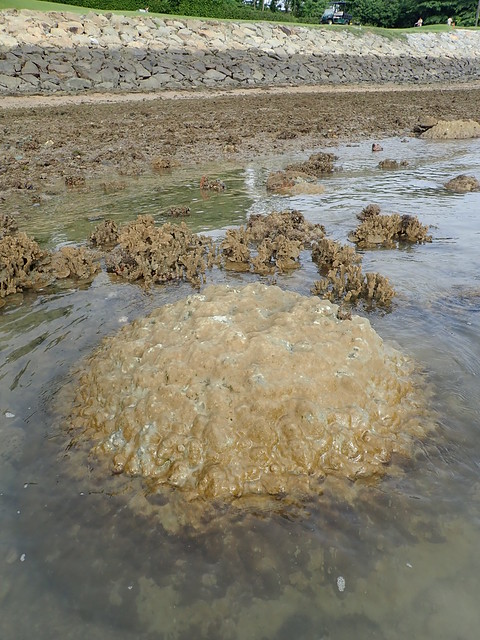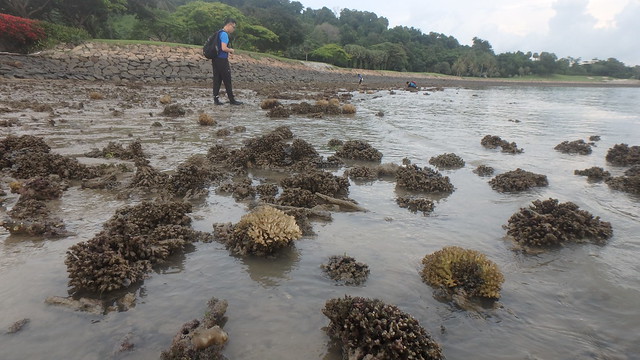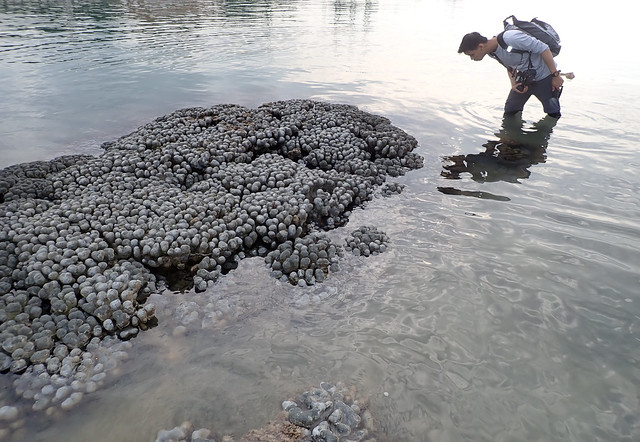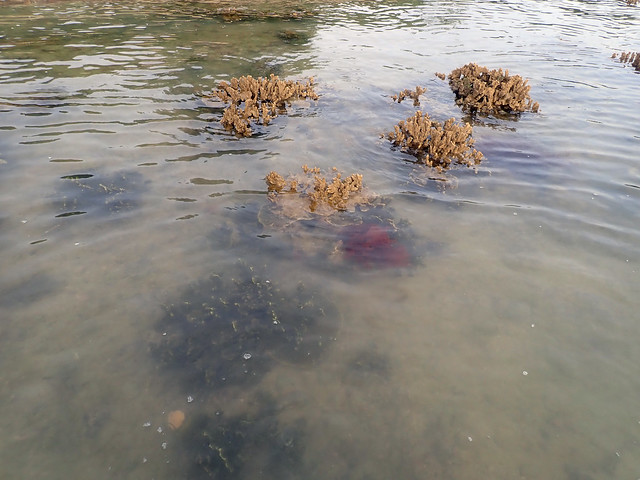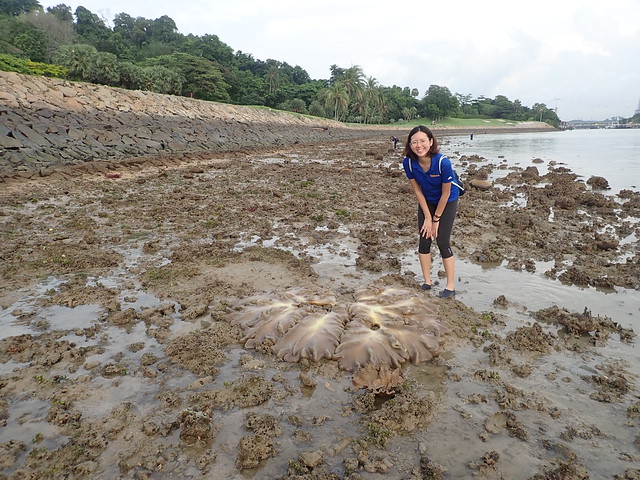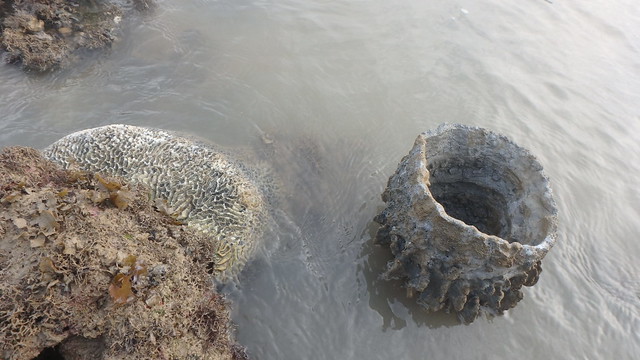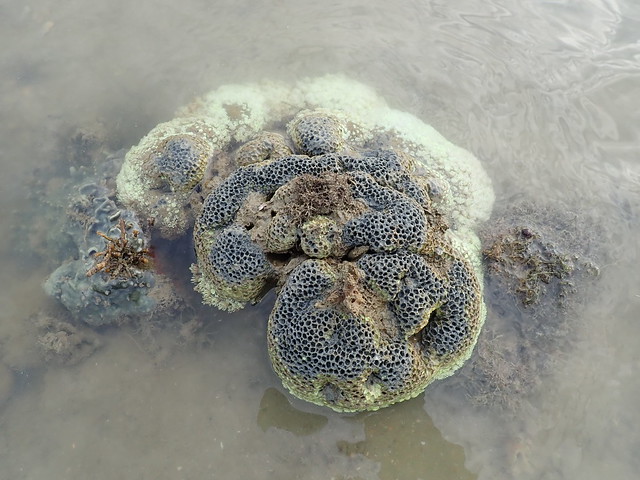 |
| Coral bleaching with dead rotting grey tops. |
It was heartbreaking to see that most of the large Boulder pore corals were badly affected.
Only a few small ones were nice and brown. The big ones had grey rotting tissue at the top, with a band of brownish slimy stuff beneath that came away when touched, and smelled bad.
Most of the Cauliflower corals were bleaching, next to colonies that died long ago and were already covered in epiphytes.
I only saw a few that were alright in deeper water.
Most of the Disk corals were also bleaching or dead or dying. Some in deeper water were alright, and small ones on higher ground seemed alright.
There are large colonies of Anemone corals on this shore. Here's Abel next to one of the several colonies found here.
Most of them had dead grey tops, with a band of brown slimy layer. In some, the bottom most part was still alive. There were a few with still healthy polyps.
The large colonies of Sandpaper coral had large portions that appeared dead, and a few Acropora colonies that I saw were bleaching or dying or dead. But Kok Sheng saw a large field of healthy Branching montipora corals further up the shore.
The Merulinid corals were mixed. Some large colonies were alright, others were bleaching or dying.
We did see healthy colonies of these corals: Lettuce coral, Carnation coral, Galaxy coral, Anchor coral, Trumpet coral and Brain coral.
In many colonies, like these large Ridged montipora corals, only the top parts exposed at low tide appear to be dead. With the portions that are submerged not as badly affected.
The leathery soft corals situation was mixed. Some had large holes, which I notice tends to happen as the colony is stressed - breaking up into smaller portions may increase the chances of at least one portion surviving. Some colonies were very flourescent, others had large patches of peeling scummy layers.
We always take a photo at this large leathery sea fan during our annual survey. Here's Annabelle sportingly posing next to it for scale. Today, it seems a little smaller than before.
Here's Shao Wei and Sheila next to the leathery soft coral during our survey last year in May 2017.
There was one Leathery sea fan that was dying at the base, but other sea fans at the old jetty seemed fine. I saw many Asparagus flowery soft corals and bluish Broad feathery soft corals that were alright. But I didn't come across any other flowery soft corals that used to be common here. I saw some zoanthids that seemed well.
The anemones did not seem to be affected. I saw several Frilly sea anemones that looked fine, as well as some Magnificent anemones, many with small anemonefishes. I even came across one Fire anemone. And Kok Sheng saw a Leathery sea anemone.
Most of the large Barrel sponges were badly affected.
They were turning brownish and grey and appear to be disintegrating. I only saw one small Barrel sponge that was alright.
Some of the other kinds of sponges were also melting or had brown patches or slimy layers. Others seemed alright.
We came across a small Fluted giant clam that was rolling in the waves, not fixed to the ground. It otherwise seemed alright. There were also still many Red feather stars. The rest of the team also saw nudibranchs, a large seahorse and other interesting marine life.
It was nice to see some patches of Spoon seagrass (with small leaf blades). The patch of Sickle seagrass appears to be thinner than before. And we saw one clump of Tape seagrass with long leaf blades and female flowers.
More photos of the mass death at Serapong today in this flickr album.
It's a mystery to us what has caused this, but it appears to be limited to the Serapong shore. Abel checked with Lena who visited Sentosa Tanjung Rimau shore a few days ago and Lena said she did not notice anything untoward. We also didn't see anything this drastic during our recent surveys of reefs near Pulau Semakau.
Let's hope this shore recovers soon from whatever is affecting the corals.
Thanks to Annabelle and Shao Wei of Sentosa Development Corp and Sheila of Serapong Golf Course for arranging our survey this morning.
Posts by others on this trip
By Loh Kok Sheng
By Dayna Cheah
By Chris Wong
By Able Yeo
Meanwhile, Carol Phillips was surveying Ubin shores

